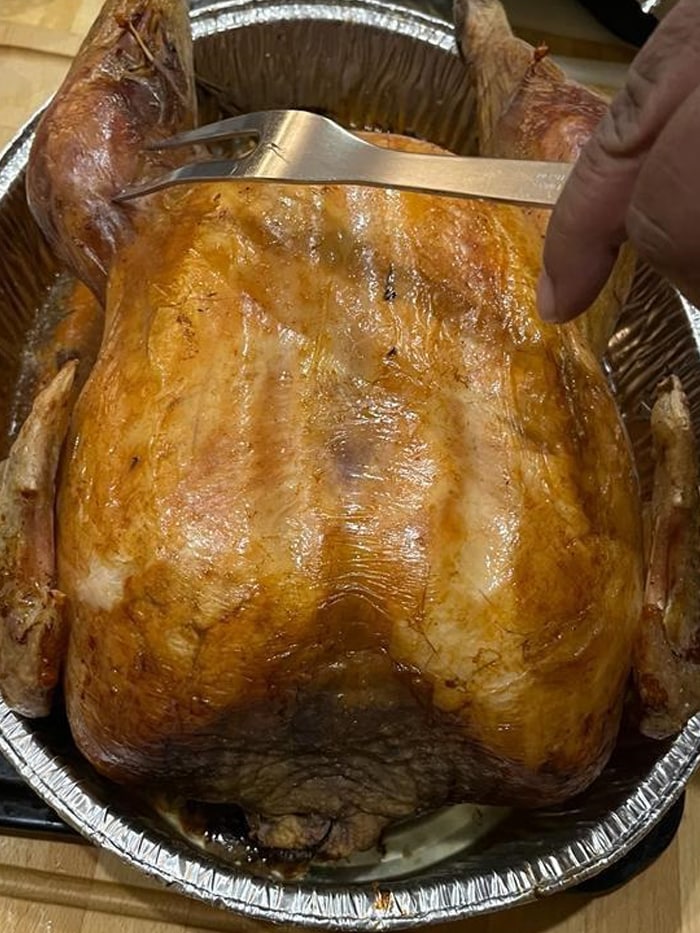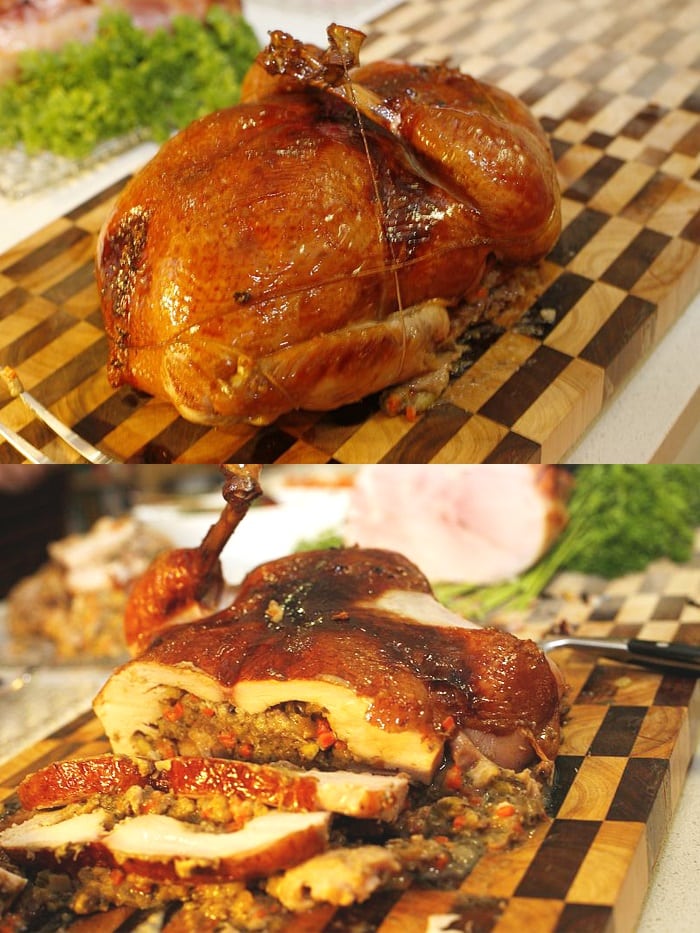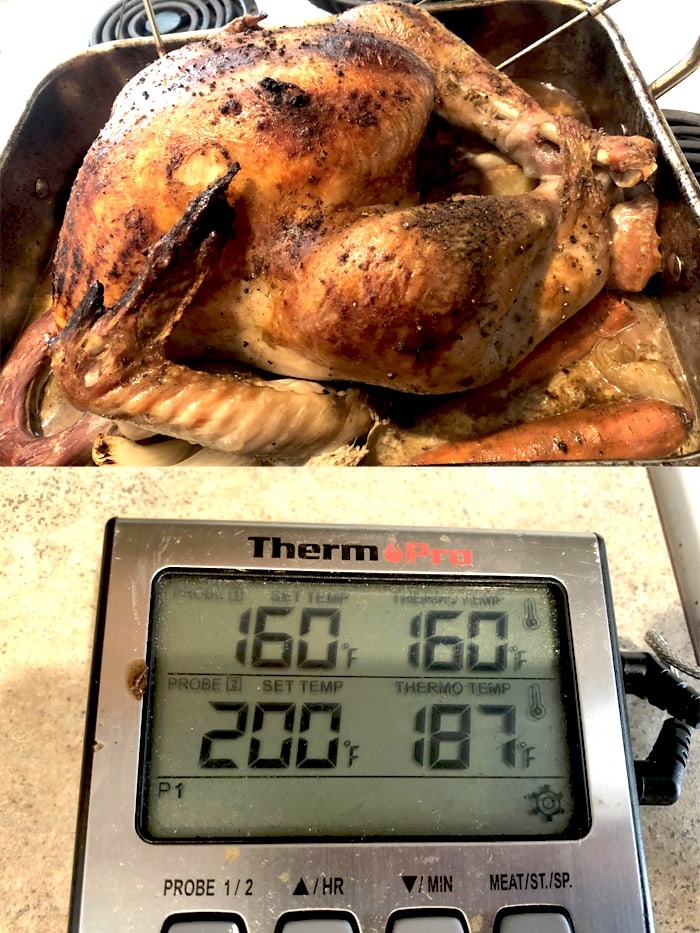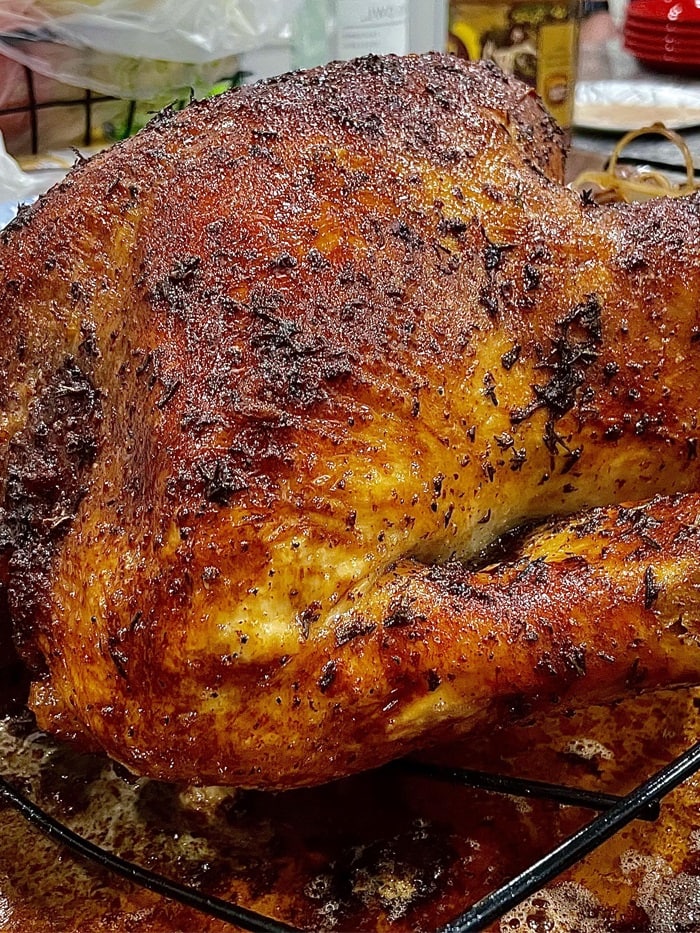It’s completely natural to feel some trepidation when you’re preparing a large turkey for the first time.
However, there’s a really simple way to tell if turkey is done without a thermometer.
The first time I roasted a turkey, I didn’t have a thermometer at hand so I had to find another way to check its doneness.
After doing some research, I found out you could tell a turkey’s ready by piercing its thigh with a fork.
In this post, I’ll explain how this method works so you can know when your turkey is cooked without a thermometer.
How to know if a turkey is done without a thermometer
Serving an undercooked Thanksgiving turkey can be a nightmare in both the literal and figurative sense.
And when you rely on generalized cooking times, the chance of this nightmare turning into reality increases.
That’s because estimated turkey cooking times serve only as a guideline without taking into account individual differences such as oven type or turkey meat quality.
Therefore, the most reliable way to tell if a turkey is done without checking its internal temperature is by performing a visual inspection.
Doing this is quite simple:
The best way to check if a turkey is done without a thermometer is to pierce its mid-thigh muscle with a fork. The mid-thigh is located just beneath the drumstick and should release a clear juice when it’s done.
Additionally, you can use a knife instead of a fork and slice the thigh to check the color of the meat.

by Kerala
If the meat has a milky white color, then the turkey is done.
Otherwise, you should continue to cook the turkey until there aren’t any pink or red spots left.
This is how the meat of a fully cooked turkey looks like:

by Keith_W
Another method you can use to check the doneness of your turkey is to grab one of the drumsticks and gently twist it.
If you feel any resistance, then you should return the turkey back to the oven.
You’ll know it’s time to pull it out of the oven when you can freely wiggle its thighs without breaking them off.
Aside from these two methods, you can also tell a turkey’s done cooking by its red pop-up pin.
If your turkey comes with one of these, the button should come up once the turkey has finished cooking.
Unfortunately, these aren’t always that reliable, and sometimes the stick doesn’t pop up at the correct temperature.
Why it’s better to check turkey doneness with a thermometer

by redbirdrising
Even though all of the aforementioned methods can be used to check if a turkey is fully cooked, they don’t give you precise control over its internal temperature.
Due to this, you can easily overcook your bird and dry it out if you get distracted.
In addition, using a meat thermometer also allows you to cook the thighs and breasts to different degrees.
This is important since the thighs need to be cooked to a higher internal temperature than the breasts. Unlike the white meat found in the breasts, the thighs are made of dark meat which contains more connective tissues that take longer to break down.
It’s the same reason why tough cuts of beef like the rump roast need to be cooked low and slow to become tender. If you don’t take this difference into account, you can overcook the breast and dry it out.
So if you want to cook your turkey evenly you’ll need to:
- Fill two quart-sized Ziploc bags with ice and join them together with a binder clip.
- Balance the bags of ice on top of the turkey.
- Leave the bags for two hours then put the turkey straight in the oven.
Another way to ensure your turkey cooks evenly is to spatchcock it.
Spatchcocking is a cooking technique in which the backbone of the turkey gets removed so it can be laid flat.
This allows the thighs to get cooked before the breasts.
What’s the internal temperature of a turkey when it’s done?
A fully cooked turkey has an internal temperature of 157°F (70°C) for the breasts and between 175°F (80°C) and 180°F (82°C) for the thighs.
The reason why we aim for these temperatures is carryover cooking while the turkey is resting.
When we use an instant thermometer we measure the temperature at the innermost part of the meat.
And while we can use this measurement to tell when our turkey is past the “danger zone” it doesn’t mean it stops cooking once it’s out of the oven. This is because the outer layers are hotter, and continue to transfer their thermal energy to the inner ones until the temperature eventually evens out.
Depending on the size of the turkey and the amount of applied heat, the internal temperature could increase by more than 15°F.
The temperature increase is largely determined by the size of the turkey and the temperature at which it is cooked.
Large turkeys have a greater surface area so they retain and transfer more thermal energy, which leads to a greater increase in internal temperature.
So by taking your turkey out at 157°F you ensure that it’s going to hit that 165°F sweet spot and stay moist instead of drying out.

by blondephotographer
To measure the internal temperature of a turkey, you’ll need to insert a meat thermometer at the deepest part of the thigh and breasts.
The thermometer shouldn’t make contact with any bones since this will give an inaccurate reading.
Once you place the thermometer, you’ll need to wait until the temperature indicator stops fluctuating.
My Takeaway
You may lack a meat thermometer, but you shouldn’t lack the courage to roast a turkey without one.
After all, the pilgrims managed to cook theirs without one, so why shouldn’t you?
Just keep in mind it might be a good idea to get one if you want to bring your turkey game up a notch.
Also, if you want to be sure your turkey is perfectly cooked for the holiday feast you can try cooking it the day before and reheating it for the holiday dinner.
This way you will have more time for potential corrections.